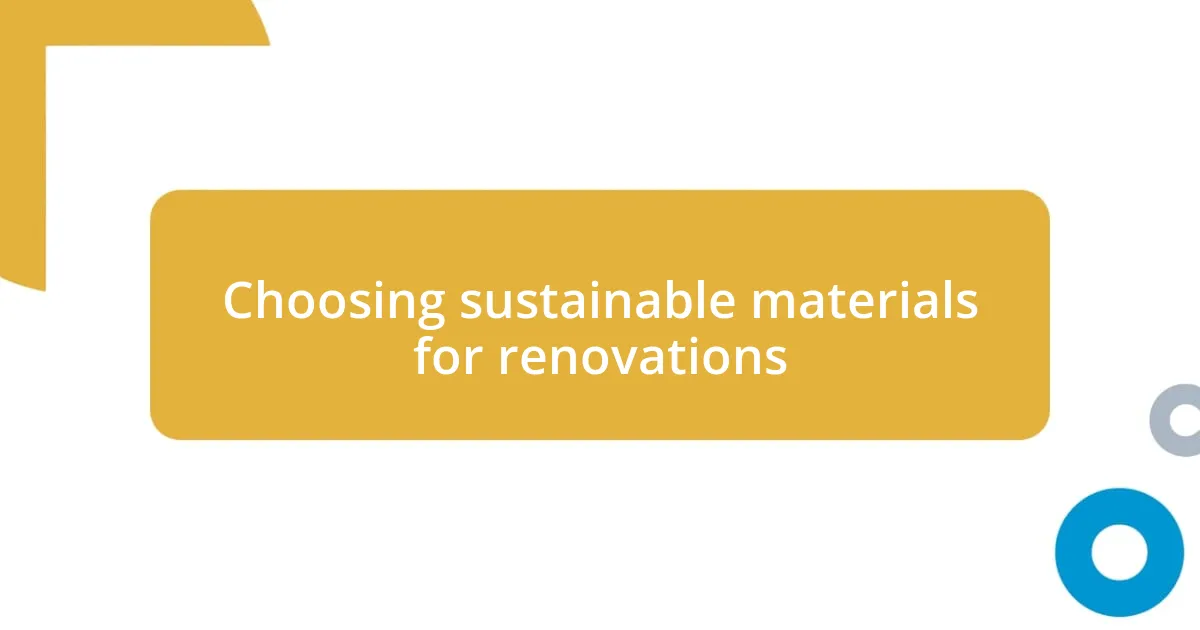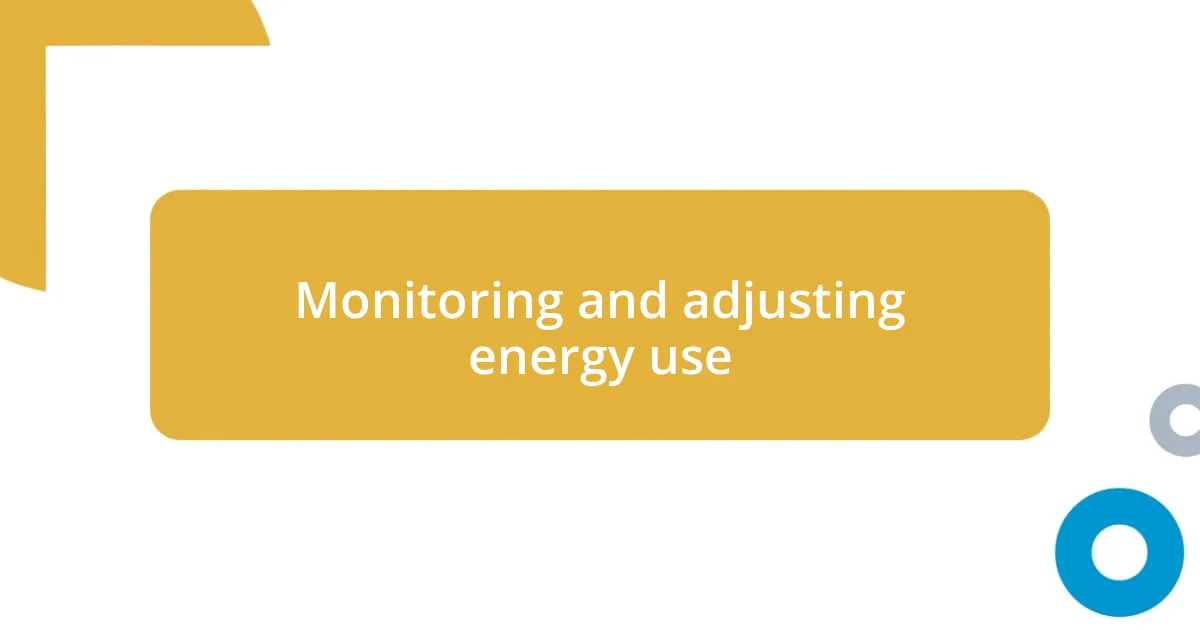Key takeaways:
- Assessing energy consumption can significantly reduce costs and environmental impact through informed choices like switching to LEDs and using energy-efficient appliances.
- Incorporating sustainable materials, such as reclaimed wood and low-VOC paints, not only benefits the environment but also enhances home performance and indoor air quality.
- Utilizing smart technology, such as smart thermostats and energy management systems, empowers homeowners to track and optimize energy use effectively.
- Regularly monitoring energy consumption patterns and making small adjustments can lead to substantial long-term savings and a more sustainable lifestyle.

Understanding energy consumption impacts
Understanding energy consumption impacts is crucial for any renovation project. I remember that moment during my last renovation when I analyzed my energy usage. It struck me how much energy was being wasted, impacting not just my bills but also the environment. I couldn’t help but wonder, what if everyone took a moment to assess their own energy consumption?
The ripple effect of energy consumption is profound. Each kilowatt-hour saved not only reduces costs but also lessens our carbon footprint, which is something I feel passionately about. I recall having a heartfelt discussion with a friend who was unaware of how much energy traditional lighting consumed. When we switched to LEDs, we not only enhanced the aesthetics but slashed our electricity use dramatically. Isn’t it fascinating to think about how small changes can lead to significant impacts?
Another surprising aspect of energy consumption is how it connects to our local ecosystems. The more we consume, the more we strain our natural resources. This realization hit home when I volunteered for a local environmental group, witnessing firsthand the effects of unchecked energy use on wildlife habitats. It made me think—how can we not only renovate our homes but also renovate our relationship with energy?

Planning for energy efficient renovations
When planning for energy-efficient renovations, careful consideration of materials and design can make a world of difference. During my own renovation, I vividly recall sifting through countless ideas and options. I was pleasantly surprised to find high-performance insulation that not only improved my home’s comfort but also significantly decreased energy loss. It was an eye-opening experience, revealing how the right choices matter.
To ensure an energy-conscious renovation, keep these tips in mind:
- Assess your space: Identify areas with potential energy loss, such as windows and doors.
- Choose sustainable materials: Opt for products with high energy efficiency ratings.
- Incorporate smart technology: Use smart thermostats and energy-efficient appliances to manage usage effectively.
- Consider passive design: Utilize natural light and ventilation to reduce reliance on artificial lighting and heating.
- Plan for renewable energy sources: Explore options like solar panels if your budget allows.
Ultimately, I found that a thorough planning phase not only saved me money but also amplified my excitement for creating a more sustainable living environment. It felt rewarding to know my decisions were truly making a difference.

Choosing sustainable materials for renovations
Choosing sustainable materials is one of the most impactful ways to promote energy efficiency during renovations. I remember standing in a store filled with various options, overwhelmed by choices yet determined to make responsible selections. It felt satisfying to opt for reclaimed wood for my flooring instead of new timber. Not only did it add character to my space, but it also meant I wasn’t contributing to deforestation. This choice made me appreciate the beauty of using materials with a history—each scratch and dent a reminder of its past life.
As I evaluated options, I discovered that many sustainable materials don’t just benefit the environment; they can also improve the home’s overall performance. For instance, I chose low-VOC (volatile organic compounds) paints, which have a healthier impact on indoor air quality. This was crucial to me, especially since I worked from home. The brisk, clean air not only provided a refreshing ambience but also kept my family safe from harmful chemicals, striking an emotional chord as I prioritized their health and well-being.
One key takeaway from my experience was recognizing the importance of sourcing local materials. Not only does this reduce transportation emissions, but it also helps support local artisans and businesses. When I sourced locally made tiles for my kitchen renovation, I felt a sense of pride knowing that I was contributing to my community while making sustainable choices. Have you ever felt that connection to your neighborhood? It made my renovation feel less like a simple project and more like an investment in the future of my community.
| Material Type | Environmental Benefit |
|---|---|
| Reclaimed Wood | Reduces deforestation and landfill waste |
| Low-VOC Paints | Improves indoor air quality |
| Locally Sourced Tiles | Supports local economy and reduces carbon footprint |

Incorporating energy efficient technologies
Incorporating energy-efficient technologies transformed my renovation experience. When I decided to install a smart thermostat, I wasn’t sure at first how much of a difference it would make. But it was a game-changer! I found myself adjusting heating and cooling remotely, optimizing energy use effortlessly. It felt liberating to see real-time energy consumption data—it was like having a personal energy coach guiding my decisions.
As I explored energy-efficient appliances, the choice became clear. I remember replacing my old washing machine with an Energy Star-rated model. Not only did I notice a significant drop in my utility bills, but washing clothes also became a less guilty endeavor. Isn’t it fascinating how a simple appliance can yield such remarkable benefits? I relished the thought of doing my part, all while enjoying cleaner clothes and saving water.
Moreover, integrating LED lighting into my home made me feel both practical and progressive. Choosing to swap out my previous incandescent bulbs felt like a small victory, yet the results were profound. The bright ambiance created a welcoming atmosphere, and I couldn’t help but marvel at the lower energy bills. Have you ever experienced such an instant reward from what seemed like a minor change? For me, it was a reminder that every little step counts in my journey toward sustainability.

Implementing smart home solutions
Implementing smart home solutions took my renovation to the next level. When I installed smart lighting, I was amazed at the control I had at my fingertips. Imagine dimming the lights from my couch while catching up on a movie! It felt empowering to not only set the mood but also reduce energy consumption with automatic timers and schedules. Have you ever thought about how much energy is wasted when lights are left on? This little change became part of my daily routine, reminding me to be more mindful of my energy use.
The biggest eye-opener for me was integrating a home energy management system. I still remember the excitement of seeing my energy consumption in real-time on my smartphone. It felt like having a personal energy assistant, highlighting the patterns and areas where I could cut back. By identifying peak usage times, I adjusted my habits and, surprisingly, it turned into a fun challenge. It’s incredible how such data can encourage you to be more intentional about usage—have you experienced that level of awareness? I sure did, and it changed how I interact with my home.
Another smart solution that truly enhanced my experience was installing smart plugs for my devices. This seemingly inconsequential addition quickly became invaluable. I love the convenience of shutting off appliances remotely, turning off my coffee maker or charging devices, and feeling a little victory. Then there’s the satisfaction of knowing I’m reducing phantom loads—energy consumed by devices that are plugged in but not in use. You’d be surprised how much energy these little things consume! Embracing these smart home technologies not only elevated my renovation but also transformed my daily routine into an energy-conscious lifestyle.

Monitoring and adjusting energy use
Monitoring and adjusting my energy use became an essential part of my daily life after the renovation. I took the time to analyze my energy consumption patterns, tracking usage through my smart home app. It wasn’t just about saving money; it became a game of self-improvement. Have you ever felt that thrill when you successfully reduce your energy consumption? It’s almost like a badge of honor, knowing you’re making a tangible difference.
To maintain those energy gains, I made it a habit to check in with my smart thermostat regularly. I remember one chilly evening when I noticed the heating was set way higher than I needed. By adjusting it down just a few degrees, I realized how little effort it took to keep my home cozy while still being energy-efficient. What’s fascinating is how small adjustments can lead to significant savings over time. Have you ever underestimated the impact of minor changes? I definitely did until I started tracking my results.
Engaging with energy data transformed how I lived in my space. One particular afternoon, I sat down with my energy reports and was astounded to see the peak usage times spiking during the early evening when everything was running simultaneously. I decided to stagger my chores, like running the dishwasher and laundry at different times. That simple change not only eased my electricity costs but also lessened my environmental footprint. It’s interesting how being aware of these habits can make such a big difference, isn’t it?

Evaluating long-term energy savings
Evaluating long-term energy savings is a journey that takes time and consistent effort. I’ve found it helpful to keep track of my energy bills over several months after my renovations. It was enlightening to notice the gradual decrease in costs; seeing the numbers reflected my hard work and strategies. Have you ever experienced that feeling of satisfaction when your efforts lead to tangible results? I certainly did. Each month felt like a little victory, and it motivated me to keep up the energy-saving habits I had adopted.
Taking a closer look at the lifespan of the upgrades I made opened my eyes to potential long-term savings. For instance, when I switched to energy-efficient appliances, I didn’t just focus on the immediate benefits. Instead, I calculated how much energy they would save over five or even ten years. I recall the moment when I realized that my initial investment would pay off many times over. Sometimes, it’s striking to think of how a single decision can reverberate through time, influencing not just my finances but also my carbon footprint. It became clear that every choice could lead to significant savings in the long run.
Furthermore, the emotional reassurance that comes with knowing my home is energy-efficient is invaluable. I remember chatting with my neighbor, who pointed out how her renovations focused exclusively on aesthetics. I couldn’t help but share my insights on the long-term benefits of energy-efficient choices. The conversation sparked a sense of camaraderie and purpose; after all, who doesn’t want to feel good about the impact they have on their household and the environment? Have you engaged in similar discussions, realizing that knowledge is often best shared? Those moments remind me how interwoven our choices are—financially and environmentally—making the journey towards energy savings truly rewarding.














